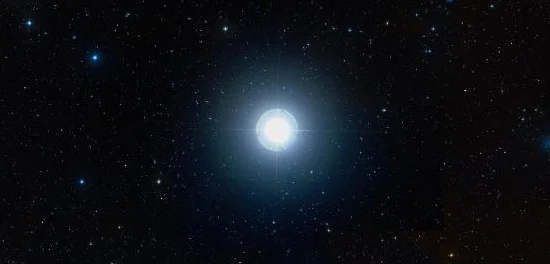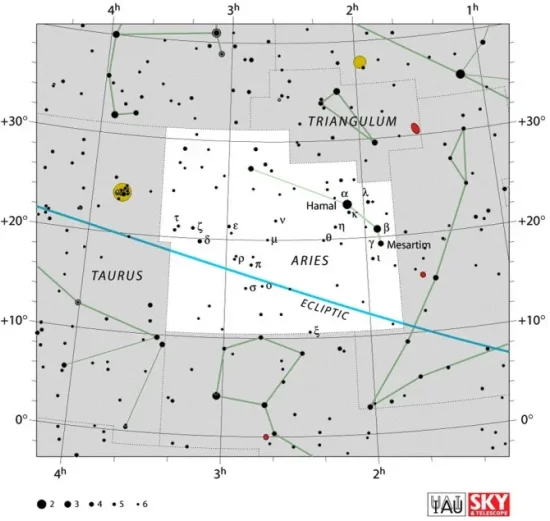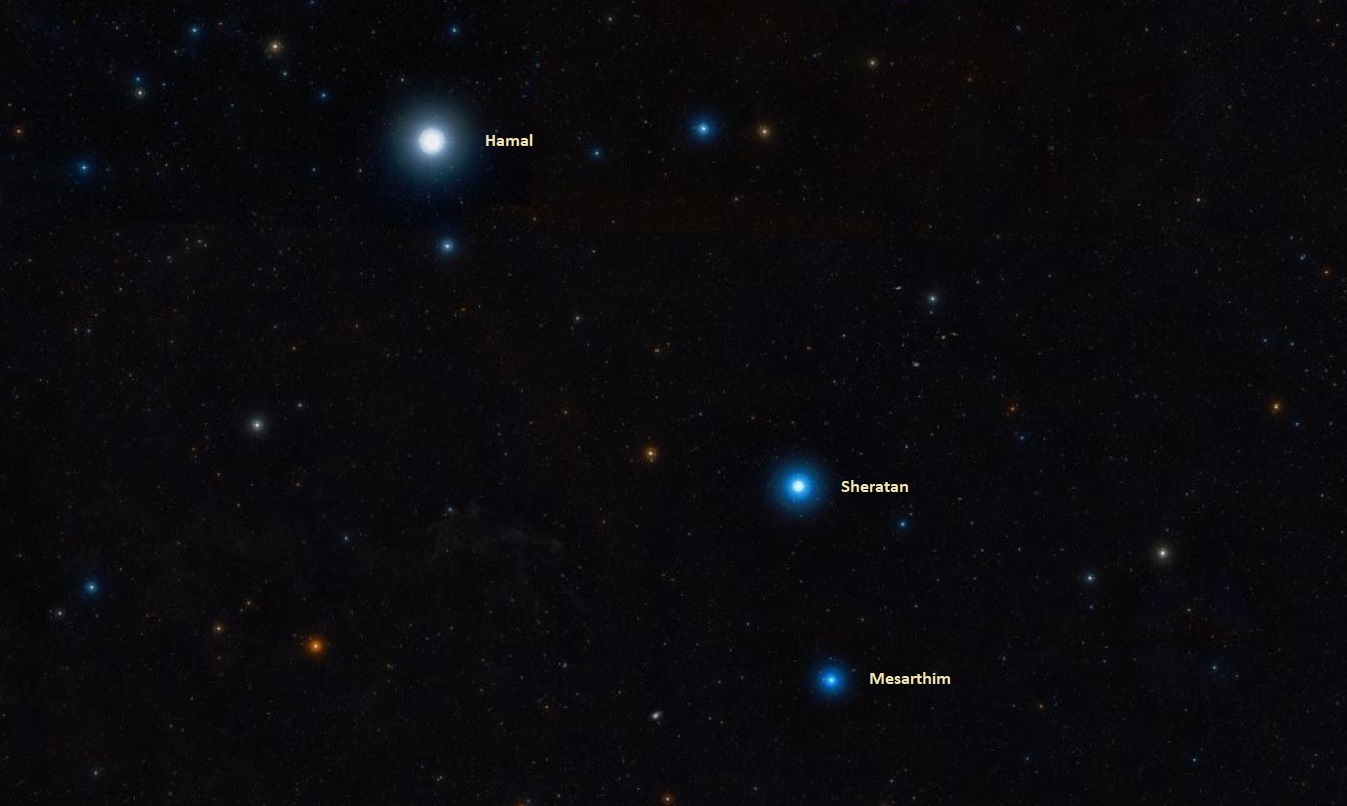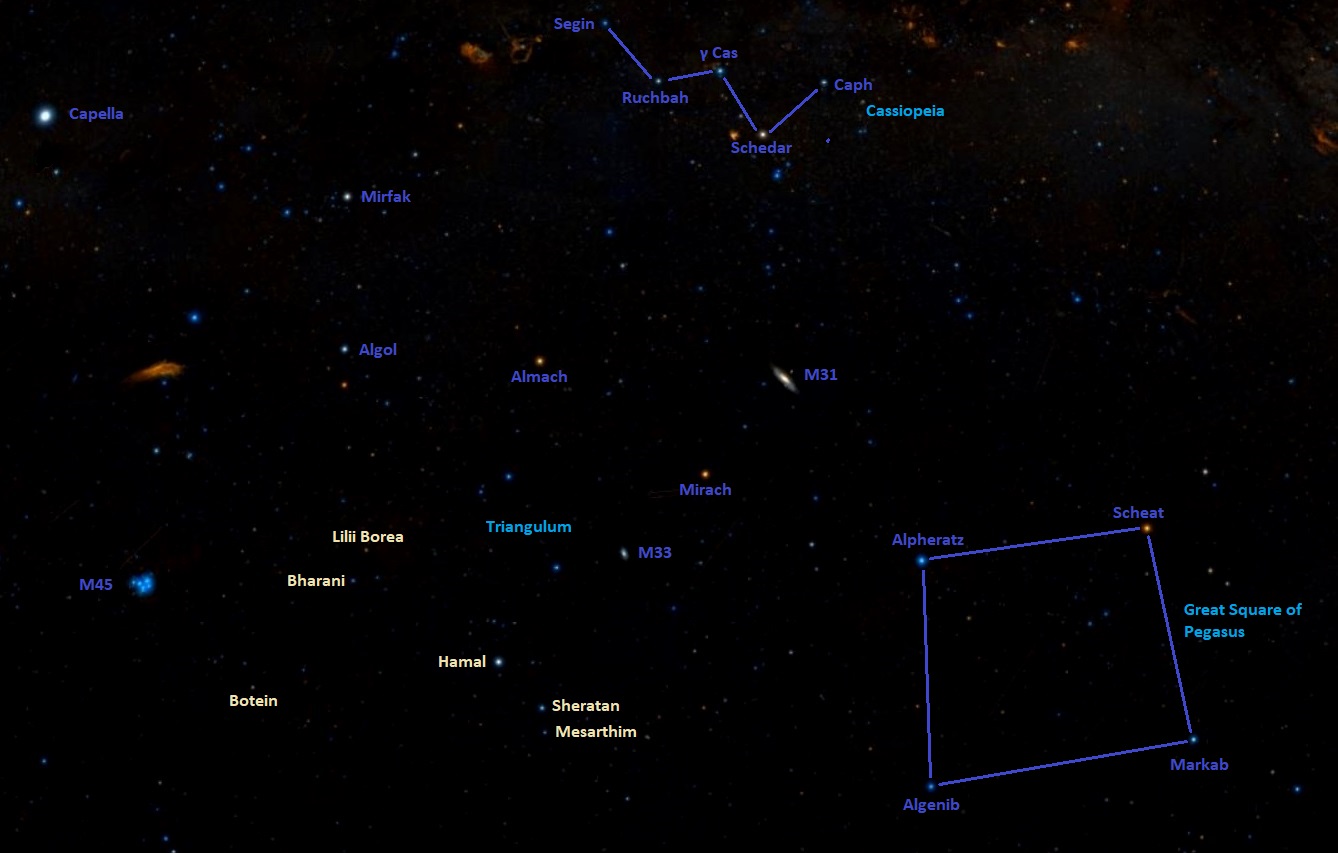Hamal, Alpha Arietis (α Ari) is an orange giant star located in the constellation Aries. With an apparent magnitude of 2.00, it is the brightest star in Aries. It lies at a distance of 65.8 light years from Earth. It may host an exoplanet with a mass 1.8 times that of Jupiter.
Star type
Hamal has the stellar classification K1IIIb or K2-IIIbCa-1, both indicating an evolved giant star appearing orange in colour. The star has burned through the supply of hydrogen in its core and is now on the red-giant branch (RGB). The “Ca-1” suffix indicates weaker than normal calcium lines in its spectrum.
Hamal has a mass 1.5 times that of the Sun and has expanded to a size of 14.9 solar radii. With an effective temperature of 4,480 K, it is 91 times more luminous than the Sun. It is a slightly faster spinner than the Sun, with a projected rotational velocity of 3.44 km/s. The star’s estimated age is about 3.4 billion years and its metallicity only about half that of the Sun.
Hamal is a suspected variable star, showing slight variations in brightness with an amplitude of 0.06 magnitudes.

Hamal (Alpha Arietis), image: Wikisky
Planet
In 2011, a candidate planet was reported by a team at the Bohyunsan Optical Astronomy Observatory in Korea, who detected it using the radial velocity method. The discovery was based on observations made between 2003 and 2010. The suspected planet has a mass at least 1.8 times that of Jupiter and orbits the star with a period of 380.8 ± 0.3 days from a distance between 0.9 and 1.5 astronomical units.
Facts
Hamal is one of the 58 bright stars selected for navigation. Navigational stars have a special role in the field of celestial navigation because they are some of the brightest and most recognizable stars in the sky. Many of them are part of a conspicuous asterism or located near one, which makes them particularly easy to identify. Hamal is recognizable for the distinctive pattern it forms with its fainter neighbours Sheratan and Mesarthim, a flat triangle. It is the only navigational star in Aries and one of the 39 second-magnitude stars included on the list.
Hamal is the 50th brightest star in the sky. With an apparent magnitude of 2.00, it is only slightly fainter than Mirzam in the constellation Canis Major, Alphard in Hydra, and Polaris in Ursa Minor, and it just outshines Algieba in Leo, Diphda in Cetus, Mizar in Ursa Major, and Nunki in Sagittarius.
The spectrum of Hamal has been used as one of the stable anchor points for stellar classification since 1943.
In ancient times, Hamal was important as the brightest star in the constellation that contained the northern vernal equinox, the point where the Sun’s apparent path crosses the celestial equator from south to north, marking the beginning of spring in the northern hemisphere. Due to the Earth’s axial precession, the equinox has since moved to the neighbouring constellation Pisces, but between 2000 and 100 BCE, it was in Aries, which is why Aries is still the first sign of the zodiac in astrology and the Sun “enters” (in astrological terms) Aries on the first day of spring. Today, Hamal conjuncts the Sun around April 24, and the spring equinox takes place around March 20. The current declination of Hamal almost exactly corresponds to the latitude of the Tropic of Cancer, and when it is not too close to the Sun, the star can be used to find the imaginary line.
Hamal is the only star individually mentioned in John Milton’s Paradise Lost. Milton refers to it as “the fleecy star that bears/Andromeda far off Atlantic seas/Beyond the horizon. (Book III. 558-60)”
Name
The name Hamal (pronunciation: /ˈhæməl/) comes from the Arabic phrase rās al-ħamal, meaning “head of the ram.” It refers to the star’s position in the constellation Aries.
The name was approved by the International Astronomical Union’s (IAU) Working Group on Star Names (WGSN) on July 20, 2016.
Hamal has been known by many names across different cultures throughout history. In Arabic astronomy, it was known as Hamal; Hemal, Hamul or Hamel, meaning “sheep,” and Ras Hammel, “the head of the sheep.” Many sources simply referred to it as Arietis, which was common practice with many of the lucidae (brightest stars in constellations).
Hamal has also been known as As-kar (from the Arabic askar, meaning “guard” or “soldier”), Dil-kar (the Proclaimer of the Dawn), and Dil-gan (the Messenger of Light). Euphratean names included Lu-lim or Lu-nit, meaning “the ram’s eye,” and Si-mal or Si-mul, “the horn star.” Hamal was also known as Anuv and Ku, meaning “the prince” or “the leading one,” referring to a ram leading a flock.
American astronomer Elijah H. Burritt called the star El Nath, meaning “the horn of the butting one,” in his 1856 “Atlas Designed to Illustrate Burritt’s Geography of the Heavens.” Today, Elnath is the star marking one of the horns of the celestial Bull, also known by the Bayer designation Beta Tauri.
The Chinese know Hamal as 婁宿三 (Lóu Su sān), the Third Star of Bond. The Chinese Bond asterism consists of Hamal, Sheratan (Beta Arietis) and Mesarthim (Gamma Arietis). It is one of the seven mansions of the White Tiger.
Location
Hamal is relatively easy to identify on a clear night. Even though it is not exceptionally bright, it forms an asterism with its neighbours Sheratan and Mesarthim that makes all three stars fairly recognizable.
Hamal is located in the region of the sky between the bright Pleiades cluster (Messier 45) and the Great Square of Pegasus, formed by Pegasus stars Algenib, Scheat and Markab with Alpheratz in Andromeda. Hamal lies just below the constellation Triangulum, identified by its conspicuous elongated triangle and located under the chain of three bright stars of the Andromeda constellation that begins with Alpheratz near Pegasus and ends with Almach near Perseus. Mirach, the central star in the chain, is commonly used by stargazers to find two of our brightest and nearest neighbours, the Andromeda Galaxy (M31) and the Triangulum Galaxy (M33).
Hamal is best seen during the northern hemisphere autumn and winter. It disappears around April, when it is too close to the Sun, only to return in the eastern sky before dawn in the late spring. It reaches its highest point in the sky on December evenings.
Constellation
Hamal is the brightest star in the constellation Aries. Representing the celestial Ram, Aries is a relatively inconspicuous constellation, with only two stars brighter than magnitude 3.00. Located near the more prominent Perseus and Taurus, the Ram can be recognized for the pattern formed by its three bright stars, Hamal, Sheratan and Mesarthim.

Aries constellation map by IAU and Sky&Telescope magazine
Like other constellations of the zodiac, Aries was first catalogued by the Greco-Roman astronomer Ptolemy in the 2nd century CE. The constellation had prominence in Ptolemy’s time because it contained the vernal equinox.
Aries contains several notable deep sky objects. These include the unbarred spiral galaxy NGC 772 near Mesarthim, the elliptical galaxy NGC 770, the interacting pair NGC 935 and IC 1801, and the NGC 691 Group of galaxies, whose brightest members include the galaxies NGC 691, NGC 680, IC 167, and NGC 694.
The best time of year to observe the stars and deep sky objects in Aries is during the month of December.
The 10 brightest stars in Aries are Hamal (Alpha Ari, mag. 2.00), Sheratan (Beta Ari, mag. 2.66), Bharani (41 Ari, mag. 3.63), Mesarthim (Gamma Ari, mag. 3.86), Botein (Delta Ari, mag. 4.349), HD 20644 (mag. 4.47), Lilii Borea (39 Ari, mag. 4.514), 35 Arietis (mag. 4.64), Lambda Arietis (mag. 4.79), and Zeta Arietis (mag. 4.89).
Hamal – Alpha Arietis
| Spectral class | K1IIIb or K2-IIIbCa-1 |
| Variable type | Suspected |
| U-B colour index | +1.13 |
| B-V colour index | +1.15 |
| V-R colour index | +0.7 |
| R-I colour index | +0.62 |
| Apparent magnitude | 2.00 |
| Absolute magnitude | +0.47 ± 0.04 |
| Distance | 65.8 ± 0.3 light years (20.2 ± 0.1 parsecs) |
| Parallax | 49.56 ± 0.25 mas |
| Radial velocity | −14.2 ± 0.9 km/s |
| Proper motion | RA: +188.55 mas/yr |
| Dec.: −148.08 mas/yr | |
| Mass | 1.5 ± 0.2 M☉ |
| Luminosity | 91 ± 6 L☉ |
| Radius | 14.9 ± 0.3 R☉ |
| Temperature | 4,480 K |
| Metallicity | -0.25 dex |
| Age | 3.4 ± 1.9 billion years |
| Rotational velocity | 3.44 km/s |
| Surface gravity | 2.57 cgs |
| Constellation | Aries |
| Right ascension | 02h 07m 10.40570s |
| Declination | +23° 27′ 44.7032″ |
| Designations | Hamal, Alpha Arietis, α Ari, 13 Arietis, HD 12929, HR 617, HIP 9884, GC 2538, GCRV 1160, PPM 91373, BD+22 306, GJ 9072, GJ 84.3, LTT 10711, NLTT 7032, SAO 75151, FK5 74, IRAS 02043+2313, 2MASS J02071038+2327447, TYC 1758-2416-1 |

